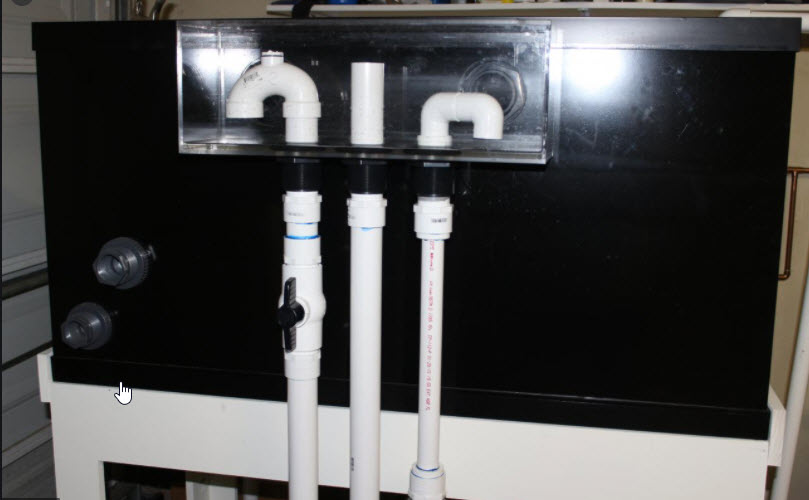
When one uses a sump the pump in the sump moves the water back up to the aquarium. Then there needs to be a way of moving the water back to the sump and to prevent the aquarium from overflowing. There are a huge number of DIY devices on the internet and YouTube that are designed to do this.
If the aquarium is drilled, then the movement of the water back to the sump can be as simple as just hooking up a tube. But if the aquarium isn’t drilled, some sort of siphon must be used to get the water over the edge of the aquarium and into the sump.
Note that a drilled tank needs special considerations if the water flow is down to a canister. The water level in the tank needs to be much higher than the drilled hole so that the piping flowing down to the sump is always completely filled with water. If the water is just flowing though an overflow in such a way that air can get into the piping leading to the canister, the canister will not flow very well up to the aquarium. The canister pumps are not designed to work without a “head pressure” feeding them. I simply do not recommend the siphon overflow designs here in or a drilled tank if one want to use a canister. Simply put the inlet hose of the canister in the aquarium.
Simple Siphon Overflow
Many prefer a variation of the simplest overflow design:
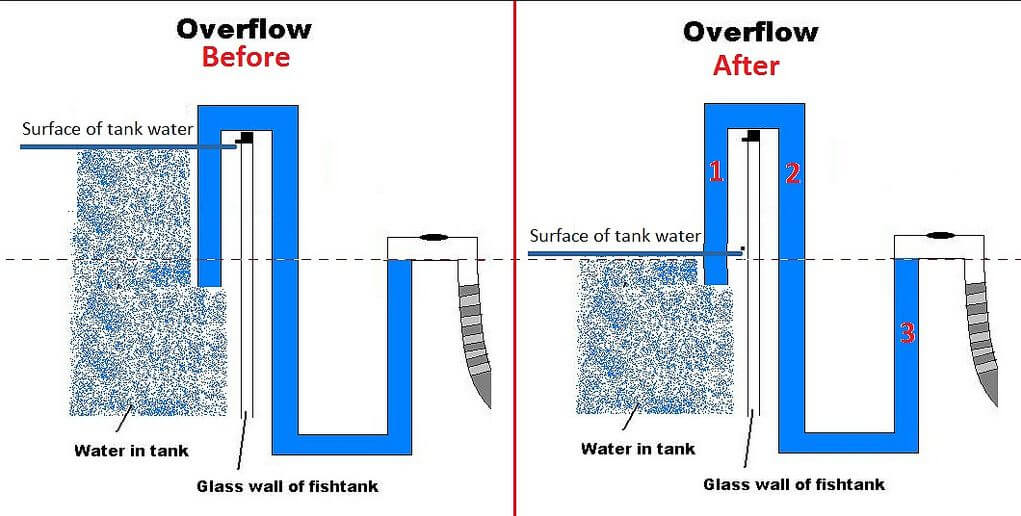
This is a very simple siphon overflow design which can’t go wrong. This design uses only one vertical pipe in the aquarium, minimizing the presence in the aquarium. The level of the aquarium is determined by the height of the open section of horizontal pipe outside the aquarium itself.
It is best to put two of these in each aquarium in case one loses vacuum on the siphon for some reason.
This simple design can be modified to:
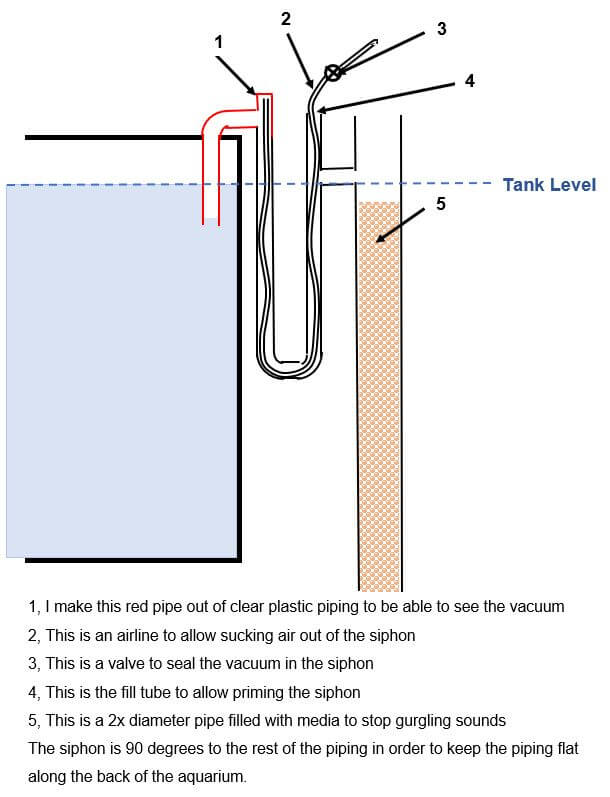
The operation of this overflow is easy:
- Open the valve 3 to air
- Fill pipe 4 with water
- Suck on airline 2 until the cap in 1 is filled with water or water comes out the airline
- Close the valve 3
- Put the end of the airline 2 into the tube outlet 4 in case the valve leaks.
- Turn on the sump pump
Again, put 2 of these on each aquarium as a cheap insurance policy.
The media in the 2x silencer tube can be anything with roughly a half inch diameter. Half inch diameter media won’t plug. And the diameter of the silencer tube needs to be at least twice the diameter of the rest of the design. Personally I use a three inch diameter PVC vertical stand pipe filled with pea gravel even with half inch overflows. The outlet is below the water level in the sump. This is the quietest overflow standpipe design I have found.
The clear PVC plastic can be obtained form many suppliers on the internet. United States Plastics Corporation has the following selection:
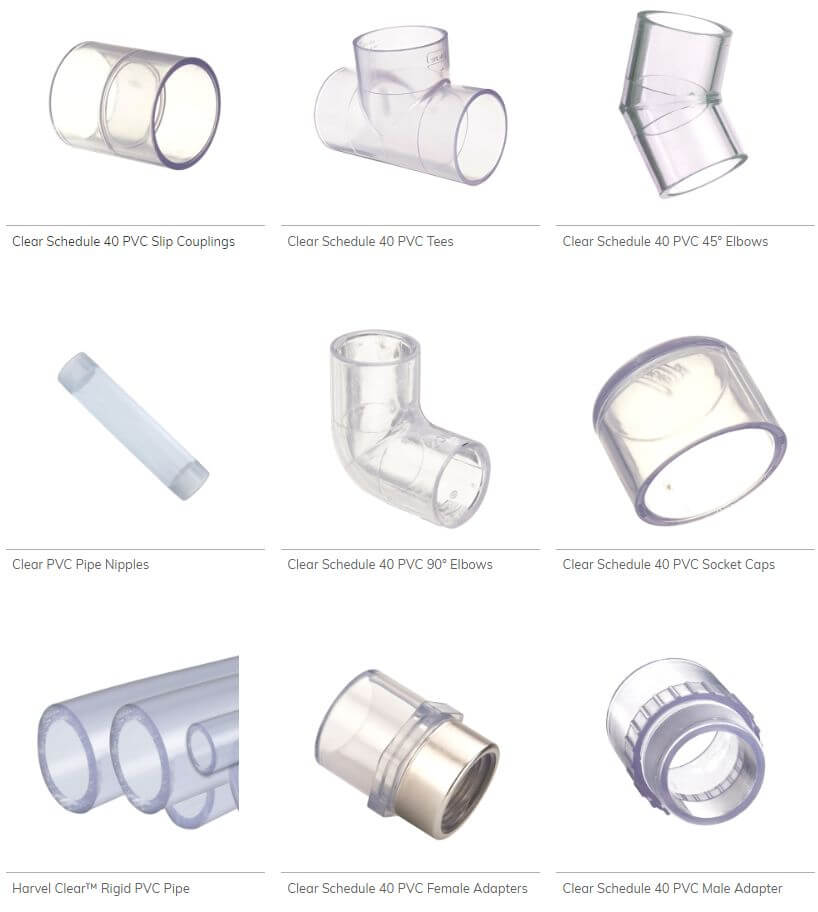
‘
“Herbie Design”
The above design can easily be made silent by making a double version of them into what is called a “Herbie overflow”. Make one of the two tubes have a level that starts working at a level about one fourth inch below the top of the aquarium. Put the outlet of this overflow above the water in the sump in such a way that it will be very noisy and acts as an alarm for the hobbyist that the primary overflow isn’t working. This is the “safety overflow”.
Then add a valve to the down pipe of the other overflow. Put the this valved overflow about two inches below the top of the aquarium. This is the primary overflow. Place the outlet of this pipe below the water in the sump.
Adjust the valve on the primary overflow to the point where the tube below the valve is completely filled with water. This may require some delicate adjusting and some downsizing of the pipe below the valve. This design is toted as totally silent. While I’ve found it works great when one adjusts it properly, it requires constant adjusting. I prefer gravel filled oversize overflow pipes.
Weir Overflow Designs
There is another very popular DIY (do-it-yourself) version of this overflow in use. Joey’s YouTube DIY videos show how to make these designs as do dozens of other folks on YouTube. Joey (“The King of FIY) also has a DIY aquarium book which goes into this design in detail. I highly recommend buying this book if you like DIY aquarium projects. The height of the water in the aquarium is determined in this design by a weir in the aquarium. This design has more obtrusive plumbing in the aquarium than the first design.
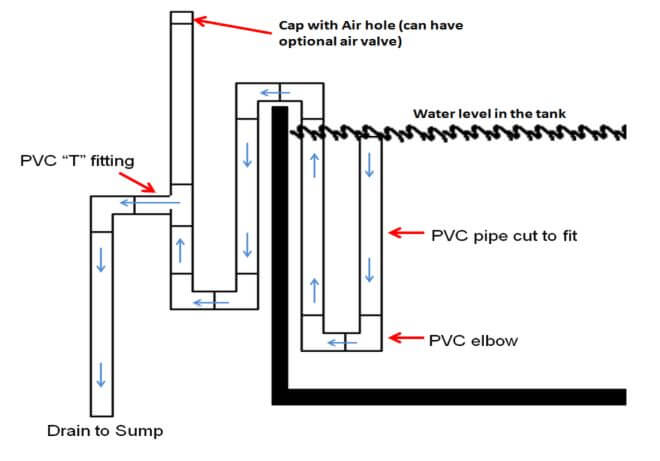
.
This simple design can be embellished in several variations:
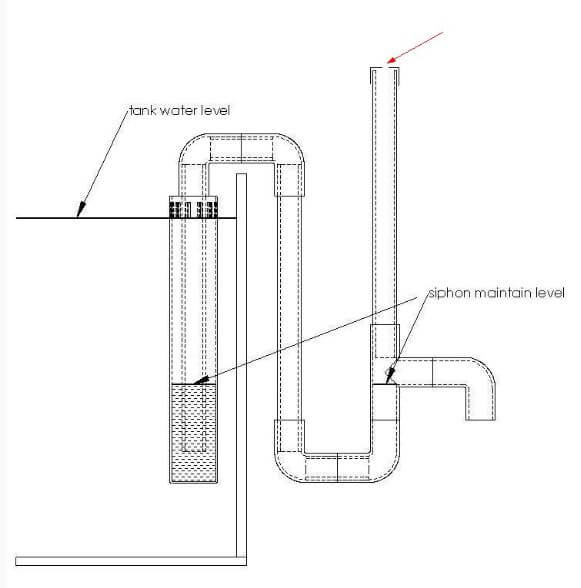
This design uses a pipe around a pipe weir design, which to me is much more attractive in the aquarium than the previous weir design.
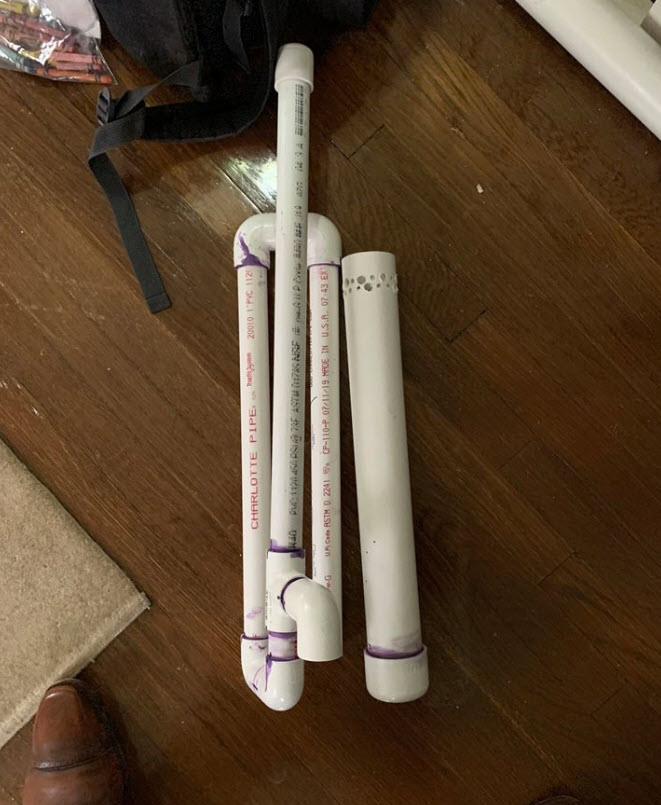
Note some people just glue an air tube to the top of the siphon in order to create the siphon. Other just plunge the whole thing into a aquarium of water and then throw it over the side with a thumb over the air hole.
This is what this design looks like in practice:
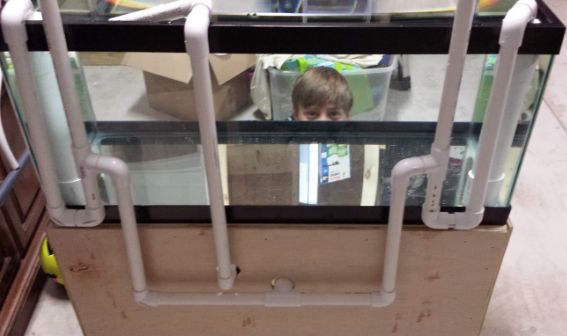
This is straightforward plumbing that anyone can do. The challenge with this design is creating the siphon. Because everything is hard plumbed this creates a bit of a difficult process. But the process becomes clearer when the sump plumbing is examined:
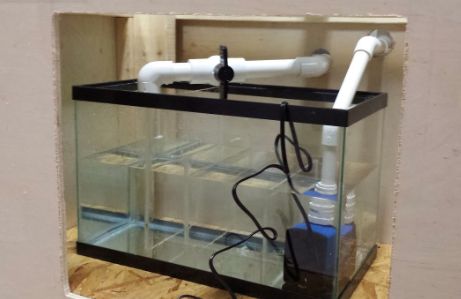
If you close the valve in the outlet over the sump, one can pull suction then on one of the air holes while covering the other air hole. If done carefully you can create two siphons. Two valves, one in each return line, would be better. It is also possible to snake air tubes through the tubing to pull siphons and using clear piping to insure the siphons are both complete with no air bubbles.
Commercially Available Overflows
There is an expensive version of this weir design sold commercially. This is the Eshopps overflow box
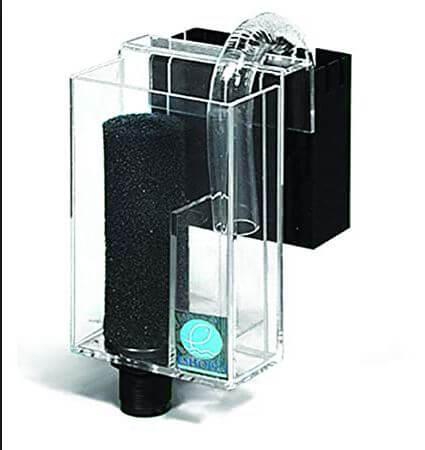
.
Eshopps overflow box
This box (really a double box) uses a weir in the aquarium to determine the height of the water in the aquarium. The water then flows through a siphon to an exterior box where the siphon is maintained by a baffle before going down to the sump.
There are also a whole series of “overflow boxes” sold largely for use in the marine aquarium (Durso Overflow, Herbie Overflow, Bean Animal Overflow). They can be used as a weir design mounted in the aquarium if the aquarium has one to three holes drilled in the bottom of the aquarium. If there are no holes in the aquarium, then a siphon tube must be added to the design and the boxes mounted external to the aquarium. They are used to prevent pipe gurgling in high flow situations.
Supposedly these designs silence the gurgle of the water falling in the pipes. Most people find they need constant fiddling with to keep them quiet. And they are very expensive. The media filled 2x drain pipe of the second DIY design is a much better option. Note the media must be large in these silencers. A small media will plug up rapidly.
Piping Sizes
All these overflows need to be designed for the following gravity drain piping sizes:
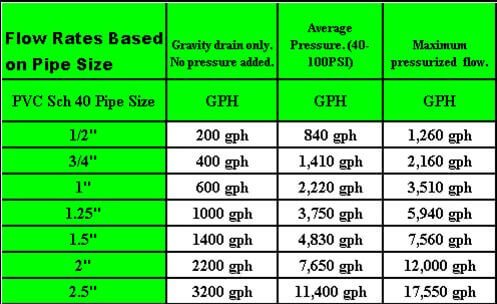
For overflows use the recommendations of the “gravity drain only” one should go oversize on this piping and as use two overflows. PVC is cheap and a wet rug and wet hardwood floor can be very expensive (believe me, I KNOW!).
.
Return to Equipment Menu
.
Aquarium Science Website
The chapters shown below or on the right side in maroon lead to close to 400 articles on all aspects of keeping a freshwater aquarium. These articles have NO links to profit making sites and are thus unbiased in their recommendations, unlike all the for-profit sites you will find with Google. Bookmark and browse!
.

Dave says
In reply to Dan ….. If you can clean the weir covering weekly use a thick “macro” or 20 ppi foam around the weir to prevent fish from getting through. If you can’ GUARANTEE weekly cleaning just accept an occasional fish loss
Dan says
Do you have any suggestions as to how to keep small fish out of these overflow boxes? I have had to rescue a lot of juvenile cardinals and otos who got sucked through the weir and ended up either in the rear box of the overflow or on top of my silencing media. I am tempted by covering the grills of the weir with foam or fine metal mesh, but I am wary of obstructing flow too much if/when plugging starts to happen.
Abhishek says
Dear Dave,
Thanks for all the useful content you have put together. I have found it very informative and useful.
I am building a DIY overflow based on your modified simple design. I have used 0.5 inch overflow pipe with a 1.5 inch drain pipe. But the flow of water is very slow (1/2 litre in 18-19 secs). There are no air bubles in the siphon. Any suggestions what I can check / do to improve the flow? Or can you point me to any youtube videos / additional content where I can see this design in real (I couldnt find any)?
Dave says
In reply to John …. I see no reason it shouldn’t work just fine.
John says
Thanks, so much! Can’t thank you enough for all the information you’ve already given.
I like many, hate vacuuming up mulm, but I still want the tank to look clean.
Most of the information for drilled tanks seems to have come from saltwater enthusiasts and-so-forth.
But I like freshwater, and plants with my fish. So… I’m thinking to drill low (in a 55 gallon acrylic tank) and instead of having a weir inside the tank, I’m thinking of drilling low (to help collect mulm) and piping up to, an aquarium-equal-level-section of a more or less regular overflow box.
To me this seems like an obvious way to do things, to move the weir to outside the main (display) tank, and then since it’s freshwater, also placing the return(s) near the bottom just above the gravel or sand cap.
Please, can you tell if you see anything wrong with this idea. I’ve never heard of this exact approach.
Dave says
In reply to Mik ….. Predicting the performance of any given overflow is very difficult and depends on 1, Plant stocking, 2, fish stocking,3 flow through the weir,4 type of fish food. Try using a different food
Mik says
Good morning! I hope you are well. First, thank you for previously explaining filter media volume calculations previously.
I have read so many of your pages on here and I came across one where you mentioned you leave your weir or overflow open top with no grate with much success. I was trying to find that page again, but can’t. I have tried open top weirs a few times for my overflows, I never have problems with fish getting sucked in, but I do lose any food on the surface very quickly and I’ve had a couple nerite snails wander into the overflow box across the weir. So, I started using a grate, but they tend to clog with food. Any words of wisdom on how to mitigate these issues?
Thanks for your time and have a great day!
Dave says
In reply to Ben Z … Since overflow siphons are driven by the level of water in the tank, not by a pump, I don’t see any method by which a pump stops then starts and somehow overflows a siphon. The pump shouldn’t affect the siphon unless the safety hole and the check valve both don’t work and the water level drops way down in the aquarium. Obviously this can fill the siphon with air and make it fail. But it requires TWO safety features to fail.
B z says
I’m in the middle of building pvc overflow siphons for my tank, and it just struck me that I have no idea where i should add unions.
Also, I’m paranoid about flooding. I know you say sumps can be made leak proof with proper plumbing design, but my concern is that overflow siphons might fail if the sump pump stops, and not automatically restart when the pump comes back on. What if I’m on vacation when that happens? Since you never used a fish sitter… what was your solution to that problem?
(I flooded my floor maybe three times when experimenting with novel setups. Two minor floods, one big one. The mopping up was not fun at all. Hence the extreme caution I take with any tank plumbing nowadays…)